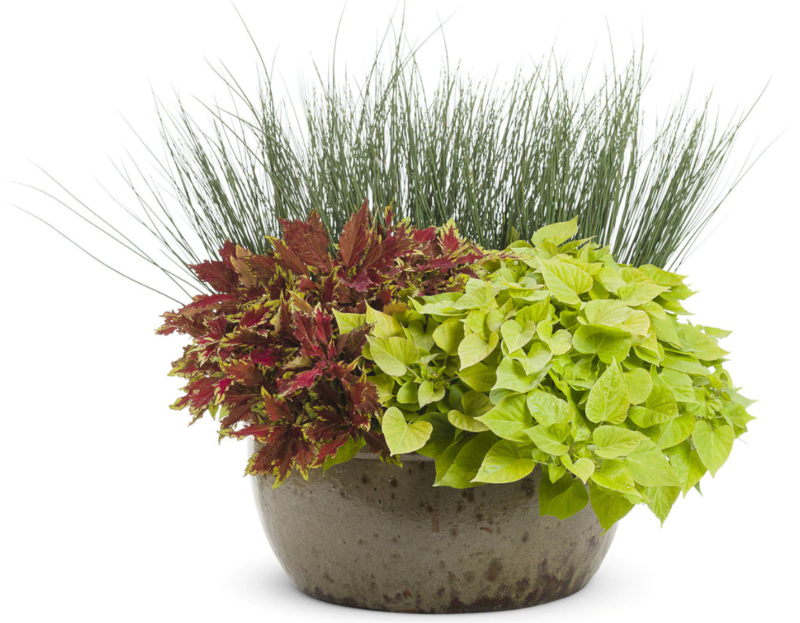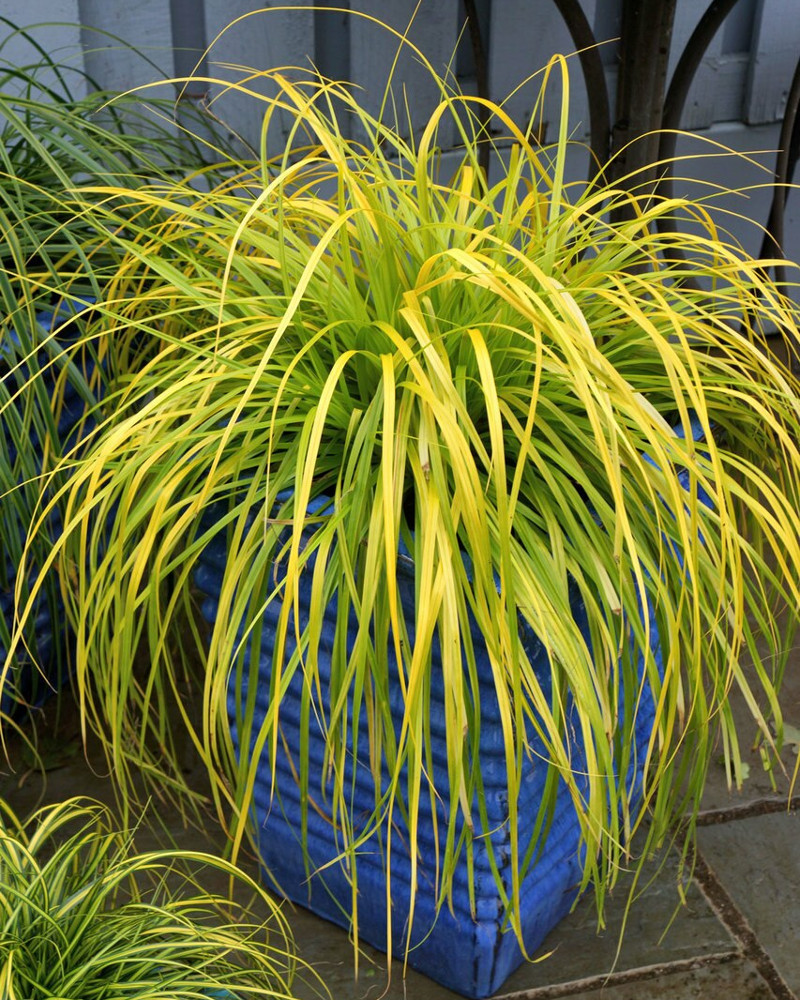Ornamental grasses are essential elements for balanced and dramatic container arrangements. The grasses add height and different textures to container arrangements with otherwise mostly flowering or bushy plants. Many gardeners place grasses in the center or back of the container as a sort of backdrop for companion plants.

Ornamental grasses can grow well in pots, assuming the soil and water requirements, and temperature hardiness of the grass you choose, align with the other plants in the container. Enjoy adding perennial ornamental grasses (like Big Blue Liriope or Dwarf Fountain Grass) to your year-round containers, or add annual grasses (like Fiber Optic Grass or Fireworks Fountain Grass) to perennial or annual containers. Whether a grass is annual or perennial in your growing zone depends on its cold hardiness and heat tolerance.
Some gardeners prefer containers for ornamental grasses that spread because growing them in a pot contains them. For example, a low, round pot of mondo grass can look attractive on steps or patio edges.
Planting Ornamental Grass in Pots
Most ornamental grasses do best if planted in spring. This gives them time to take root and survive the shock of transplanting before peak heat begins. In warmer zones, you can plant some grasses in early fall. They need time to be watered and get established before temperatures drop.
Most ornamental grasses grow best in full sun, or mostly sun with partial shade. If the plant seems to be burning, you can move the container to an area with a little more shade. Choose a container that is slightly larger than the root ball of your grass, up to about 8 inches wider in diameter to account for several years of growth or spread. Some grasses, like Hakone grass, have shallow roots and can grow in small containers no more than 6 inches deep. Others, such as miscanthus or giant reed grass, have deeper roots and need a taller pot.

The confined area of a container likely will keep a grass from growing as tall as its plant tag says it will reach. That can be good, since some grasses reach heights of 5 feet and more when grown in the landscape. Make sure the container you choose has a good drainage hole or drill a hole if repurposing metal pails or other objects.
Best Soil For Ornamental Grass in Pots
Plant ornamental grasses in balanced soil that drains well. Although the potting mix should not dry out completely, especially while the plant is young, you also want to avoid soggy soil. Use a loose mix designed for containers. Using top soil or ground soil does not work in containers. Eventually, the soil compacts and roots can't get the air they need to grow.
Caring For Ornamental Grass in Planters
If growing a perennial grass, cut it back to about 4 to 6 inches above soil level in spring. Just replace any grass that did not tolerate winter cold and fails to come back in spring. Or grow an ornamental grass alone in a container and place it where the sun and breezes strike the long blades. Other than annual pruning and watering, ornamental grasses need little attention.
Watering Ornamental Grass in Pots
Even though most ornamental grasses can handle periods of drought, they need more water to establish roots in the first month or more after planting. This is especially true when growing them in containers, which dry out more quickly than the ground. And it is even truer if you choose a clay container (which dries quickly) or if you have a cool-season grass in a container during peak summer heat. In general, water grasses in containers a little more often than care instructions say for ground-grown plants. Be sure to water slowly; drip watering is best.

Fertilizing Ornamental Grass in Pots
Most ornamental grasses require no fertilizing since they are striking for their foliage and don't need extra energy to produce fruit and colorful flowers. However, nutrients in the potting mix fade over time, and it might be beneficial to work a layer of compost into the top soil of the container each spring. If foliage looks pale or yellow, apply a slow-release balanced fertilizer in spring to keep foliage healthy.
Winter Care For Ornamental Grass in Pots
A grass that can handle winter temperatures in your growing zone should survive winter in the ground, but an ornamental grass planted in a pot needs to be a few zones hardier to survive the cooler environment of the container. You also can bring ornamental grasses inside for winter protection if their winter hardiness is close to your average lows.
If you cannot bring a container inside, you can winterize it by wrapping it with bubble wrap or a thermal blanket. If possible, move the container to a south-facing wall to help absorb daytime winter sun. If a perennial grass has spread to the edges of the container, it is best to divide it to help keep the container from cracking.

Can Ornamental Grass Be Grown Indoors
If you want to overwinter an ornamental grass indoors, choose its sunlight exposure based on its outdoor sun needs and whether it typically goes dormant in winter. Grasses that go dormant can get by on minimal light but should not be placed in a dark closet either. Dormant grasses need little watering while indoors in winter, just enough to keep the potting soil from drying so much it begins to separate from the container edge. Water evergreen and annual grasses regularly in winter, but do not let the container soil get soggy.
 |
Author Teresa Odle - Published 11-14-2020 |
